The fungus on the fingers of the legs is a problem that botheres many.Itching, burning and unsightly kind of skin and nails is only a small part of it.The disease is dangerous with complications that are even more difficult to heal.However, it is possible to cope with the problem if you seriously treat the treatment of fungal infections (mycosis).
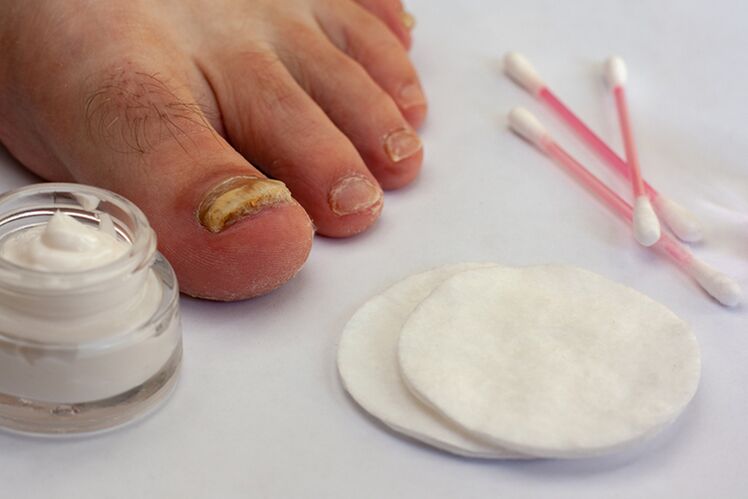
Why does the mushroom appear on your feet?
Mushrooms are one of the types of infectious agents that affect the skin.These are difficult and extremely stubborn microorganisms.Therefore, fungal diseases require a serious and integrated treatment approach.
Mushrooms have their favorite rooms on the skin.First of all, it is the skin of the toes and nails.The reason for this is understandable - the feet are usually in the shoes in which a lot of moisture and dirt accumulate, as well as very hot.Therefore, mushrooms that live on their feet, have a lot of food and a cheap microclimate for the spread.Some types of complex mushrooms often influence the skin, and other types of mushrooms, for example yeast and mold, prefer nail plates.Perhaps a simultaneous infection with different types of mushrooms at the same time.
To develop mushrooms to the fingers, contribute to:
- reduced local and general immunity;
- bad foot hygiene;
- uncomfortable and cramped shoes;
- irregular change in socks or stockings;
- Wearing socks or a stocking of synthetic materials that do not pass the air;
- Regular hypothermia or overheating of the feet;
- Circular disorders in the legs;
- Varicose veins;
- Chronic diseases of the cardiovascular system, diabetes mellitus;
- a long treatment course with antibiotics;
- increased sweating of the legs;
- Lack of vitamins and mineral elements in the body;
- Mechanical damage to the skin, grain, feet trauma;
- Excessive physical weight on the legs;
- An irregular haircut of nails on the legs.
The most important of these factors are reduced immunity and blood flow to the legs.A decrease in immunity can occur for various reasons.Usually these are serious chronic diseases, mainly infectious.In addition, the immunity can lose weight due to HIV and take immunosuppressants in cancer.A violation of blood circulation in the fingers of the legs is no less important for diseases of blood vessels, blood, diabetes and smoking.
Stop myocoses can develop in men and women.They occur more often in adults than in children.
Some types of mushrooms are constantly inhabited on the skin and are only activated under adverse circumstances, for example fungi of the genus Candida.And other types are transferred from person to person.An infection can occur when visiting the gym, the bathroom, the shower if a person does not use personal shoes at the same time.Even people who attract the shoes or socks of another or allow other people to use them expose themselves to a significant risk of infection.Infection often occurs when the same towels, manicure supplies, etc. are used factors that increase the likelihood of infection, cuts on the skin surface and deformation of the nail plates.
Symptoms of finger mycosis
The main symptoms of foot mycosis itch and burn.Small redness, small bubbles, increased peeling and negotiating the skin, an unpleasant smell can also be observed.The first symptoms of skin mycosis can be confused with simple irritation and gratitude.
Symptoms of onychomycosis
The mushroom can not only influence the skin, but also the nails.The last mycosis variety is called onychomycosis.The main symptom for onychomycosis is a change in the structure and the type of nail, the increase in brittleness.The nail becomes yellow, furrows and cracks appear on its surface, the nail plate thicker and deforms.If you do not treat the treatment, the nail gradually becomes out of the nail bed and collapses.
What does the mushroom look like on your finger: photo?
You should not diagnose alone through photos.The diagnosis should be made by a qualified dermatologist.
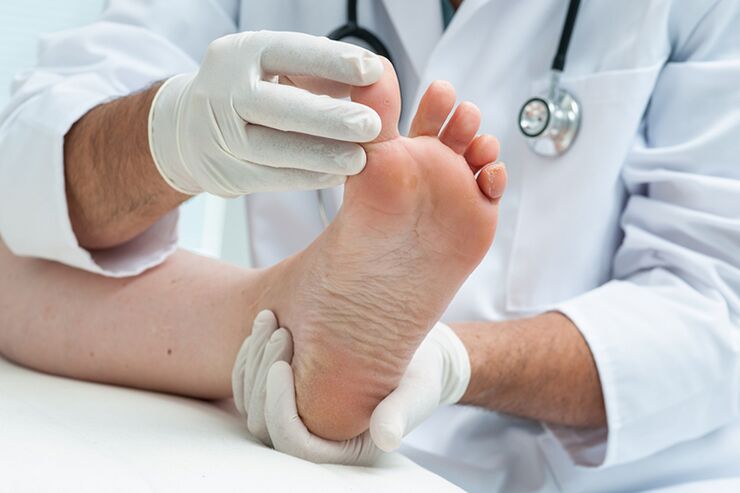
Only he can determine the type of fungus.To do this, he may not only need an external examination of the feet, but also laboratory tests of skin scraps.
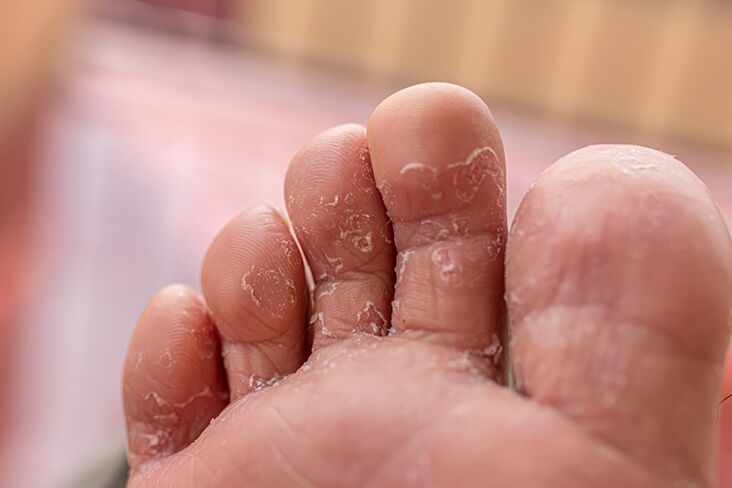
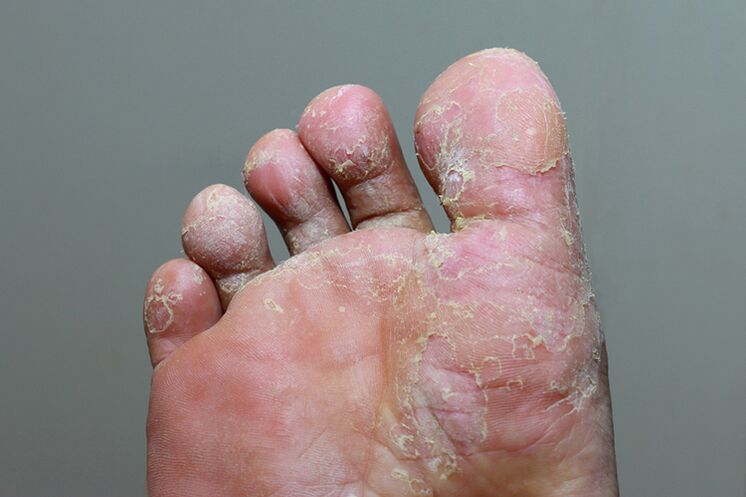
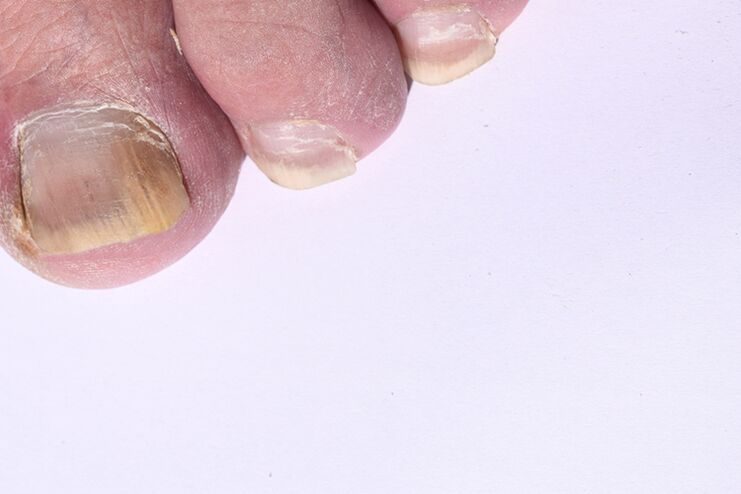

However, the presence of signs that are similar from a distance from the photos shown in the photos is an occasion for concern and seeing a doctor.
The treatment of the disease is comprehensive and is carried out at home under the supervision of a doctor.
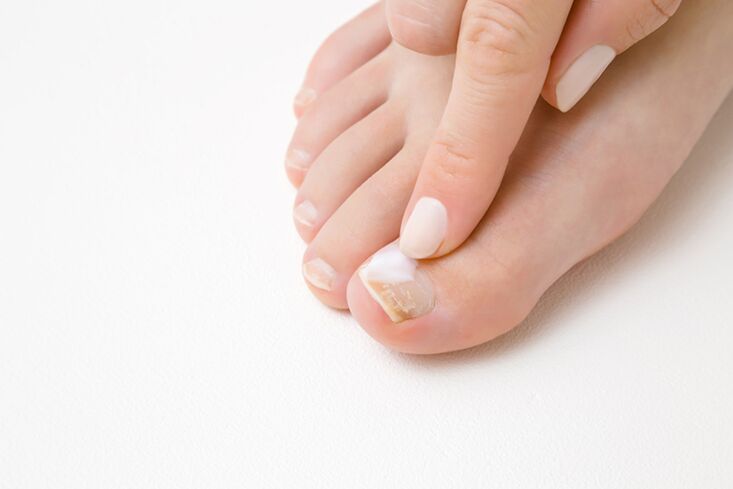
Mushroom on the little finger
The mushroom can affect the skin of each finger of the foot.But the little fingers on the leg are most susceptible to the infection.The little finger in tight shoes is often compressed, which means that abrasion and the blood circulation is disturbed on the skin.With damage to the little finger's finger, the disease develops very quickly, faster than with any other nail.If the infection is infected with a little finger, it can touch other fingers very quickly.
The mushroom on the little finger is treated as well as the mushroom in other skin areas.With the onychomycosis of the little finger's finger, the most rational output can be the removal of its nail plate.This operation will not cause great inconvenience to the patient because the nail grows quickly on the little finger.Although the nail does not grow again (this can take 3-4 months), it is necessary to use antifungals to prevent new infection.
How do I treat the mushroom on my fingers?
The treatment of mycosis should begin with the first alarming symptoms.First you have to contact a dermatologist for diagnosis.Before the therapy begins, it is necessary to determine the fact of the existence of mycosis and the type of pathogenic microorganisms.For this purpose, the doctor takes a scratch out of the skin or cuts a piece of nail (with damage to the nail).Blood tests, blood for sugar are donated.The mikosis of the skin of the feet must be distinguished from:
- other infectious skin diseases;
- allergic reactions;
- Dermatoses caused by diabetes, vascular diseases, stress and nerve diseases.
Local products (sprays, ointments, creams) are used most frequently to treat mycosis on the legs.Only in severe cases can the doctor prescribe antimicotic tablets.Most frequently used tablets with fluconazole, itraconazole, terbinafin.
The treatment is based on the use of antifungal.This type of medication contains substances that kill mushrooms (fungicide) or stop their reproduction (fungistatically).
Which antimikatic agents are most frequently used:
- Clotrimazole,
- Ketokonazole,
- Terbinafin,
- Nistatin,
- Mikonazole,
- Environment,
- Fluconazole.
Local medicines with antibacterial, anti -inflammatory and keratolytic properties are also used.Antibacterial active ingredients are prescribed when the addition occurs, ie the bacteria are bound to a fungal infection.In anti -inflammatory medication, copy well with unpleasant symptoms - itching and combustion.However, they do not influence the cause of the disease - pathogenic microorganisms.Keratolytic agents include zinc, sulfur and sulfur ointment.They accelerate the regeneration of skin tissue due to the acceleration of the exhaustion of the dead epidermis.
For the therapy of the mycosis of the stop, bathrooms with antiseptic active ingredients - solutions of potassium perhanging, iodine, salt, food sewers and boric acid are used.Baths are best performed 20 minutes before going to bed.To prevent infection with spores, you need to treat healthy skin areas with chlorhexidine, iodine, hydrogen peroxide and potassium perxy.Lacomicosis therapy is used with antifungers - Looceril, Exoderil, batrophen.These paints must be applied to the nail plate.
Ointments and creams must be applied to pre -washed and clean skin, whereby the frequency specified in the instructions for the product is specified.The area of application of the ointment should be slightly larger than the area of visible damage.In order to apply the nail onto the nail plate, the nail must be steamed, the uneven edges should be sanded with a file and the surface of the nail should be removed with an alcoholic solution.
In folk medicine, the decoctions of medicinal plants are used to eliminate mycosis on the legs - chamomile, calendula, sage, St. John's spice, mint, vinegar, onion and lemon juices.
What to do if the mushroom doesn't pass on your finger?
The treatment of mycosis is a long and difficult process.Mushroom microorganisms are very persistent, and in a few days it is impossible to get rid of them.Sometimes careful therapy is required for many months.At the same time, it is impossible to interrupt therapy for a single day.Treatment of onychomycosis can only be completed when a new, healthy nail plate grows.
It is also important to consider other factors associated with the development of the disease.If you do not adhere to skin hygiene and the optimal temperature regime of the feet, you can reduce all therapeutic efforts to zero.This means that it is necessary to wash the skin surface regularly, to avoid overheating or hypothermia.It is also important to avoid mechanical damage to the skin, excessive load on the feet, cuts and injuries.Excess weight increases the pressure on the feet.So if you suffer in abundance, you should think about losing weight.
If the patient is constantly wearing a mushroom with a mushroom, there are no strong medication here, since the place of the dead microorganisms will immediately occupy new ones.It is therefore necessary to remove all factors that contribute to the re -i infection.You can't go into another socks in another.Socks must be washed thoroughly and changed regularly.The inner surface of the shoes should be sprayed thoroughly with anti -in -fixed active ingredients.
With persistent mycosis, it is necessary to analyze the general state of health.Perhaps this helps to identify the causes of impaired immunity and blood circulation in the legs.It is therefore possible to undergo a complete examination and to exclude problems with heart, blood, vessels and organs of the endocrine system.
After all, it is possible for microorganisms to simply develop resistance to the anti -crops used.Then it will be necessary to change the drug.Perhaps systemic anti -makers in tablets are required.The dosage of the medication should be selected by a dermatologist.


























